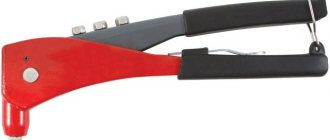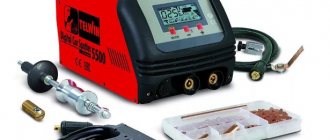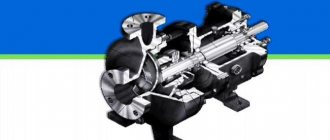Classification of shovels
First, it’s worth understanding what a shovel is. A shovel is a tool for manual digging of soil, as well as clearing various types and types of areas from foreign materials: debris, earth, snow and other things. Essentially, this is a canvas, mostly metal, attached to a handle, which in Russia is most often made of wood.
For your information! This instrument has been used since very ancient times, when it was made from wood, bone (from an animal shoulder blade), elk horn, etc.
Of all the existing hand tools, shovels are perhaps one of the most necessary. With their help, you can do anything: dig up soil, cut it, dig a hole, make beds, hill up bushes and trees in a summer cottage, clear the area of snow, scatter sand, crushed stone, manure, gravel and humus around the site.
You can survive in extreme conditions with the help of special types of this tool by digging a dugout, cutting down a tree and cutting up a hunting trophy. In military conditions, it can be used in combat, defuse ammunition and dig a trench. You can take the finished bread out of the oven, use it in steel smelting, or put out fires. Truly, it is an indispensable tool. It's hard to find a more common piece of equipment with such versatility.
All about shovels
Like any other tool, shovels come in different types and shapes, which offer a variety of uses and purposes. Among the main types of shovels, the following are primarily distinguished:
Bayonet shovel
It has a working part made of metal, mounted on a handle, most often wooden. This is the most common type of garden shovels for working in the field, vegetable garden, and garden. Used in agriculture, homestead farming and in excavation work. The main part is pointed towards the center in order to cut into the ground with great force, which is not the case with other types of shovels.
Among bayonet shovels, titanium shovels have recently become increasingly popular due to their low weight, high strength, low metal adhesion, durable sharpening, and rigid metal part. The disadvantages of titanium shovels are their high price and fragility.
Note! Also among bayonet shovels there is a type called a drainage shovel. It has a durable working part with an extended collar, which allows you to conveniently dig narrow ditches and trenches. Such shovels from Truper are popular among manufacturers.
For the hardest and toughest soil, special soil cutting shovels are used. These include the Vyatka Plowman shovel, which is used for manual digging of soil for planting agricultural plants and for cleaning shallow trenches. It has a ploughshare and is designed for only one working leg. After digging the soil with it, it looks as if it had been tilled with a walk-behind tractor.
Truper shovels
Spade
This is a fairly old type of instrument and is practically not used today. These are shovels with special edges that require pressing with your foot, allowing you to cut into the ground with even greater force. The working base of the spades is made in the form of a rounded cutting edge, which allows it to be used more effectively for digging even the hardest soils. There are spades with a long blade and with working bases curved forward. As a rule, these are quite large shovels in size.
Small infantry shovel, or sapper shovel
It is usually 50 to 60 cm long, so that it can be carried constantly on a belt or in a case. The instrument consists of a wooden handle and an iron base, pointed towards the center. It is used for digging various types of soil, as well as quickly digging trenches, digging up mines and ammunition and their prompt disposal.
Note! Sapper shovels are used not only in the army, but also in folk medicine, since with their help many herbalists dig up the herbs and roots of medicinal plants they need in forests and fields.
Snow shovel
Its working part is usually very wide, which is made of plastic, aluminum, various sheets of plywood, as they are the lightest and easiest to operate. The main task of such a shovel is to move as much snow as possible to clear the area of precipitation. Such a tool for collecting and removing snow, which does not have a tray, but simply a flat blade, is called a slider.
Important! Another type of shovel is a dustpan, characterized by a short handle, which is usually located across the general plane of the tool. It is used to dump trash that has been swept into a heap.
The official classification of shovels according to GOST 19596-87 is as follows:
- construction;
- gardening;
- loading and unloading.
We work with all of Russia
We carry out orders coming from Chelyabinsk and the Chelyabinsk region, as well as from other regions of Russia. At the same time, you can choose any delivery method convenient for you - from self-pickup to delivery by a cargo carrier company whose candidacy suits both parties as much as possible. If you are having difficulty finding such a company, we will identify suitable candidates for you. Strict adherence to delivery deadlines, safety of goods in transit, as well as during loading and unloading are guaranteed! If you have any additional questions, if force majeure circumstances intervene, we will provide prompt communication with the management of our online store, which will dispel your misunderstandings.
Our online store works both with individuals (including individual entrepreneurs) and with enterprises that engage in small-scale and large-scale wholesale sales. We offer representatives of the business world the opportunity to become official partners of our company. To do this, you need to fill out a short application that accompanies the description of each product in the “Products” section, indicating your contact information. As soon as companies or organizations interested in purchasing wholesale quantities of agricultural or construction tools contact us, we will immediately direct potential clients to you, which will serve our mutual benefit. Join our team - the team of success!
Special purpose shovels
Shovel
In addition to those mentioned above, there are also special-purpose shovels. Among them:
- Military. They are used for tactical purposes in military conditions for narrowly defined tasks. There are two types: infantry (MPL-50, BPL-110) and sapper (MSL-50, BSL-110). They are used for camouflage, overcoming artificial obstacles on the battlefield, as edged weapons in hand-to-hand combat, and for cooking as a frying pan. They are usually worked while lying down, kneeling or sitting, depending on the situation. At the beginning of work, the tool is driven into the ground with the corner of a steel tray, cutting through the small roots found in the ground. They work like this continuously for 10-15 minutes, after which they rest for 5-10 minutes. and continue working again. In this way, you can perform a larger amount of work than with continuous digging without rest for 45-50 minutes.
- Tourist shovels are combined folding products that combine a scoop, bayonet, saw, ax and many other tools. The design can be folding or telescopic. They can not only dig, but also chop, cut, etc. in the wild and in extreme survival conditions.
- Other specialized types of shovels designed for specific purposes. These are cleaners' scoops, bakers' wooden shovels for removing finished bread products from the oven, steelworkers' four-meter shovels, picking scrapers and a huge number of homemade devices for various needs. There is also a fire shovel. Its purpose is to extinguish fires and throw soil at fire. Typically, they are stored in the fire department, mounted on a wall-mounted shovel holder on the backboard among other equipment. Fire shovels can be either bayonet shovels for localizing a fire by digging the soil to a mineralized layer, or shovel shovels for throwing sand and earth onto the fire.
- Shovel with crutch.
Shovel with crutch.
There are also very highly specialized types of this tool, but these are most likely trays, each of which is designed for a different type of soil, material, etc., for example, a shovel for loading potatoes, similar to a fork, but at the end has a partition equipped with rollers .
As you can see, each shovel is designed for a specific purpose, and the choice of which shovel to use depends on the task at hand.
Types of bayonet shovels, what they are intended for
In fact, there are not so many of them.
- The blade shape is round. For work on virgin soil, unplowed soil, which is difficult to dig with a cone-shaped blade. This tool is convenient for turning over turf and digging fairly deep trenches.
Bayonet shovels with a rounded blade must be perfectly sharpened, and the curved upper edge provides a reliable support for the foot. However, such a tool is very heavy and expensive.
- The blade shape is rectangular. For deep loosening of soft soil and removing large amounts of snow. It is also used for breaking ice, cutting off a layer of turf and some other tasks not related to digging up the earth.
- A lightweight design with holes or slots on the blade - for digging up crops, for example potatoes. The root crop remains on the canvas, and the soil spills into the holes, and this greatly facilitates the effort.
@minemshop.ru
Selecting cuttings
Bayonet shovel
What is a shovel made of? Handle and cutting part. There are a number of criteria for choosing a handle for a shovel:
- the material from which it was made. For bayonet types, as a rule, wood cuttings are used, and for modern scoop types they are often used from various plastics or light aluminum. Also extremely popular are shovels with metal handles made of stainless steel. There should be no nicks, knots, wormholes or any cracks on the wooden ones. Hardwood species lead in quality: birch, ash, alder;
- a shape that is usually straight, but scoop types may have curved or humped handles or have a handle at the end for more comfortable work;
- diameter can be different: from 34 to 40 mm;
- the length is also selected individually. The standard length of the handle varies from 900 to 1400 mm.
Choosing a cutting
Features of the metal working part
Miracle shovel drawings and dimensions
The metal part of the tool must simultaneously meet two conditions: to be as strong as possible and as light as possible. Its task is to cut the soil as easily as possible, lift it, and break up the earthen lump. The only materials that satisfy these requirements are steel or titanium. Among garden shovels, the first option is most often used. Steel for garden shovels comes in the following types:
- spring or rail. It is made from a grade of steel similar to that from which rails are made. This material easily resists corrosion;
- hardened steel. Working parts made from it are suitable for periodic use for gardening purposes. Most garden tools are made from this material;
- polished. By polishing the steel, friction on the plane of the blade is significantly reduced. Tools made from it are suitable for older people and will be indispensable when working in a sticky environment (for example, with clay or loam);
- Stainless steel is designed for constant work in aggressive environments: with solutions, saline soil, cement. Stainless steel is often used for gardening purposes;
- with Teflon coating, to which even viscous soil does not stick. This shovel can be used to dig even in the most swampy places.
Important! Titanium bayonet shovels have recently become increasingly popular. Despite the price, fragility, rarity, they are considered more convenient for working in the garden.
Forged shovels are most valued, but they also cost more. This is understandable, since forging a shovel is very labor-intensive.
Shovel as a household tool
The industrial market for working tools offers a choice of classic shovels (hand-held devices) and electric models, which in their functional properties are similar to small cultivators, belonging to a separate type of equipment and intended mainly for cultivating a fairly large area.
There are models no longer than 20 cm and easily fit in the palm of your hand. But these are not children's shovels, but a tool designed for working in greenhouses and planting plants in flower pots.
For construction work and garden digging, larger models are used, some of which have a telescopic handle to adjust the height of the handle in accordance with human height.
This design feature is also convenient because such equipment does not take up much space, it is easy to store, transport in the trunk of a car and other methods of transportation.
Selection, modification, storage, care of tools
One of the most important parameters when choosing a shovel is the selection of the metal part. First of all, you need to pay attention to the stiffening ribs on the working part. They are guaranteed to extend the life of the shovel, and also ensure the easiest and most labor-intensive process of dumping soil (it will stick to a lesser extent). It is better to sharpen the cutting edge for a specific job: digging up soil with grass, cutting roots. Another important point is sharpening the shovel. It can be done using a grinder. Speaking of storage, you need to remember that the instrument should be kept clean and dry so that it lasts for many years. Also, to extend the life of the tool you need:
- clean the shovel after work, because organic matter and moisture are the main source of oxidation; in other words, they provoke corrosion of the metal part, which leads to the unusability of the tool;
- Strengthen and paint the wooden handle in a timely manner. The paint will protect it from environmental influences (from dampness and drying out), which will also quickly lead to unusability. The tool should not become loose, therefore, even with minimal play, you need to disassemble the fastenings, tamp and strengthen the handle towards the working part, re-fastening it. In such cases, nails are much more reliable than self-tapping screws;
- sharpen and straighten the metal part. The working edge must be periodically sharpened so that it cuts the soil easily and effortlessly. Bends and dents must be straightened so that the working part enters and cuts the soil along a straight path without unnecessary effort, thereby making the work easier and saving energy;
- You need to store your equipment in a specially designated room for garden equipment, well ventilated and free of moisture. An ideal option would be wall-mounted shovel holders.
Store in a special place
Also an important point when caring for this weapon is attaching the plate to the neck (clamp) of the handle. This part is also called the tulle. The tulleka can be stamped (a single part of the fabric) or a separate part, fastened with rivets. The first option, when broken, is completely replaced; the collapsible option allows for partial replacement. At the same time, much more soil always sticks to the blade fastened with rivets, which is a significant inconvenience during work. Therefore, the choice of fasteners is also an important criterion before purchasing a shovel.
With proper care, careful handling and timely attention to detail (handle, crown, working part), the tool can last for many, many years.
As you can see, this type of work tool is distinguished by its enviable diversity and versatility, can perform various functions and is absolutely indispensable both at a summer cottage and at a construction site, in production and other areas of life. Anyone who decides to choose a shovel for one purpose or another will have to analyze many of the factors described above. Having studied the selection criteria completely, you can go to the store. Knowing what and why is needed in the work, even an inexpensive purchase will not be a disappointment, but, on the contrary, will serve faithfully for many years.
0 0 votes
Article rating
We evaluate manufacturers
When choosing the quality of a shovel, you should pay attention to both the materials and the manufacturing company: how well its name is known on the market, where it is located, how long it has been in business, what reviews users of its products give. The price being too inexpensive is alarming: most likely, such a tool was produced by a manufacturer with a dubious reputation or simply by a craftsman who worked “on his knees.” If a product is found to be defective, it will be almost impossible to find such a “craftsman” and bring him to justice.











